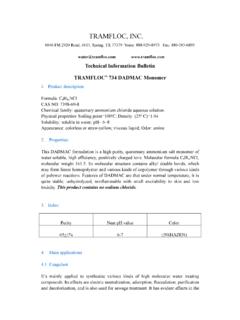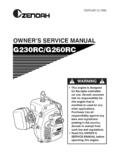Transcription of REQUIRED MATERIALS FOR THE CYLINDER SHAKE …
1 1 TRAMFLOC ANTIFOAMING AND DEFOAMINGEVALUATION PROCEDURESREQUIRED MATERIALS FOR THE CYLINDER SHAKE TEST One 250 ml and one 1000 ml beaker Variable speed electrical mixer Low shear mixing blade such as Jiffy Blade Balance Kelzan water ( Kelzan S solution in water with preservative) 100 ml graduated cylinders 1% solution of the Sodium salt of Dodecylbenzyl Sulfonic Acid (NaDDBSA) Transfer pipette or syringes StopwatchMETHODP repare 200g 10% defoamer dispersion in thickened in a 250 ml beaker the appropriate amount of thickened water, preferably Kelzan Ssolution. (Appropriate amount: 200g minus the amount of defoamer) the necessary amount of the defoamer concentrate so you will end up with 200g 10% it for 5 minutes at approximately 500 rpm with a low shear mixing blade such as JiffyMixer . Please note that high shear conditions will break any defoamer emulsion causingerroneous results and excessive oiling. DefoamingThe first part of the measurement is a test for defoaming, also known as quick knockdown.
2 It shows howgood the product is at destroying foam once it has 45ml water in the 100 ml graduated 5ml of the 1% NaDDBSA to the CYLINDER so the resulting foaming medium will be the CYLINDER for 60 seconds in such a way that you perform two full SHAKE cycles in everysecond, 120 shakes total. As a result the foam should reach the top of the CYLINDER leaving no freeairspace. If the foam does not reach the top, it indicates a contaminated the stopper and add one drop of the 10% defoamer to the foam using the transfer pipetteor syringe, and start the stopwatch at the same the time when the top of the collapsing foam reaches the 60cc mark and when it goes flat . Flat is when the foam first opens up exposing the liquid surface. Also record the foamheight at 60 seconds if there is any and zero the stopwatch after five minutes and record the foam height, if there is any foam atthat The second part of the measurement is to determine the antifoaming properties of the specific Tramfloccompound.
3 Antifoaming is the property of the material that if it is properly dispersed in a foamingmedium it can prevent foam the stopper in the CYLINDER and SHAKE it for sixty seconds just as it is described in point the sixty seconds SHAKE put the CYLINDER on the counter without delay and start the initial foam height, the time REQUIRED for the foam to collapse to sixty cc, and the timeto go flat . Also record the foam height after five minutes if there is any foam at that the above test two or more times if more accuracy is REQUIRED . It is very practical to use thefollowing grid to record the test results.#1#2#3#4#nMethodCSTCSTCSTCSTCSTI nitial FoamTime to 60ccFoam at 60 Foam at 5 ShakeReshakeTime to 60ccFoam at 5 REQUIRED MATERIALS FOR THE WRIST ACTION SHAKE TEST A 250 ml beaker 8 oz round, glass, screw cap bottle Variable speed electrical mixer Low shear mixing blade such as Jiffy Blade Balance Kelzan water ( Kelzan S solution in water with preservative) 1% Triton X-100 solution Transfer pipette or syringe Stopwatch BURREL Wrist Action ShakerMETHODP repare 200g 10% defoamer dispersion in thickened in a 250ml beaker the appropriate amount of thickened water, preferably Kelzan Ssolution.
4 (Appropriate amount: 200g minus the amount of defoamer.) the necessary amount of the defoamer concentrate so you will end up with 200g 10% it for 5 minutes at approximately 500rpm with a low shear blade such as Jiffy Mixer .Please note that high shear conditions will break any defoamer emulsion causing erroneousresults and excessive 100g of the 1% Triton X-100 into the 8oz of the 10% product to the bottle and close the the bottle around to disperse the the bottle in one of the clamps of the wrist action shaker. Set the shaker for maximumamplitude and SHAKE the bottle for ten stopping the shaker record the time to flat . ( Flat is when the foam first opens upexposing the liquid surface.) Also observe and record the dispersibility of the antifoam in theTriton X-100 the Wrist Action Shaker for consecutive 1, 5, 30 minutes using the same sample the time needed to go flat . The trade names of the above listed surfactants are registered by the mark owners and are shown assuggestions 080803







